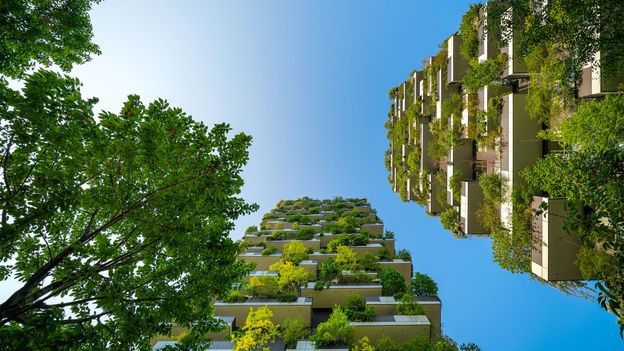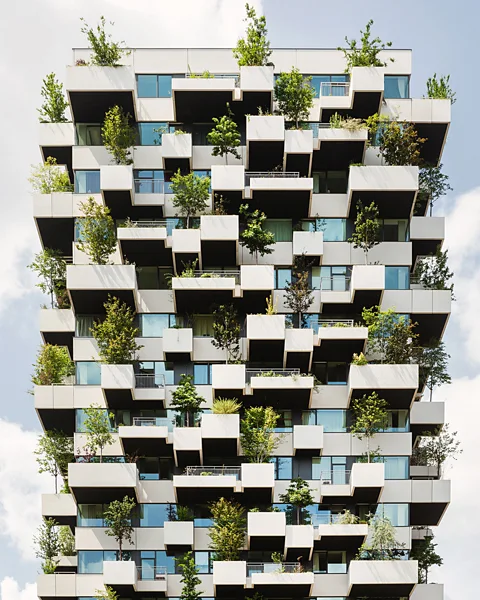 Eindhoven, Netherlands/ Stefano Boeri Architetti
Eindhoven, Netherlands/ Stefano Boeri ArchitettiIt has been 10 years because the creation of the primary vertical forest, Milan’s Bosco Verticale. How has it impressed different buildings – and affected their residents’ happiness and well being?
In 2007, Italian architect Stefano Boeri witnessed the frantic development of a metropolis within the Dubai desert dominated by energy-wasting skyscrapers lined in glass, ceramic and steel. All these supplies, he tells the BBC, “mirrored daylight, producing warmth within the air and particularly on the city floor, the place pedestrians walked”. Three thousand miles away, he had simply begun engaged on his personal design for 2 very tall buildings in a uncared for space of northern Milan. “Instantly, it occurred to me to create two organic towers… lined not with glass, however with leaves,” he says. The design would invite fauna and flora into this industrial wasteland and funky the air inside and outside, providing a radical new architectural prototype that, he explains, “integrates dwelling nature as a constitutive a part of it”. The startling outcome was the world’s first “vertical forest”.
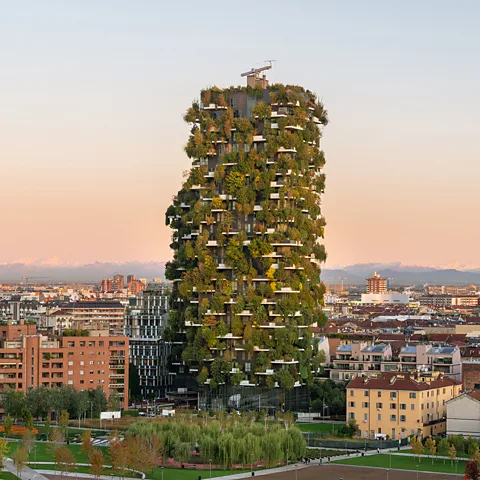 Boeri Studio/ Dimitar Harizanov
Boeri Studio/ Dimitar HarizanovThe multi-award-winning design is now 10 years outdated, its crops maintained by “flying gardeners” harnessed to the aspect of the buildings, and its occupants as much as three levels cooler, because the foliage releases water vapour and filters the daylight. To mark this anniversary, architectural agency Stefano Boeri Architetti has launched a brand new ebook, Bosco Verticale: Morphology of a Vertical Forest, that includes essays by main voices working on the intersection of nature and structure, alongside pictures by architectural photographer Iwan Baan. The ebook traces the evolution of the venture and the rules it espouses, and, say the publishers, Rizzoli “celebrates an architectural work that has develop into the image of a renewed collective sensibility towards take care of the setting and the plant world”.
In a reversal of the standard architectural hierarchies, the ebook describes the vertical forest as “a house for timber and birds, that additionally homes people”. It attracts on philosophies and texts which have influenced it, similar to The Secret Lifetime of Timber (2006) by British biologist Colin Tudge, a piece that explains the essential function timber play in our lives in sequestering carbon, producing glucose and offering shade. It additionally quotes the British ethologist Dame Jane Goodall. As populations improve, she asserts, “it’s desperately necessary that this progress ought to be accompanied by new incentives to carry the pure world into present cities and into the planning of recent ones”.
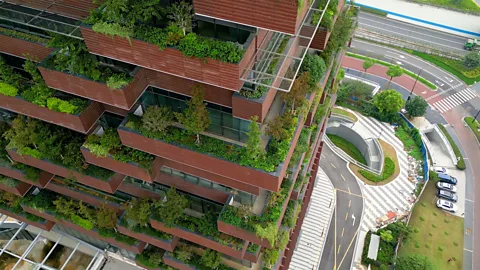 Stefano Boeri Architetti
Stefano Boeri ArchitettiBecause the completion of Milan’s Vertical Forest, a inexperienced wave of plant-rich development has begun reintroducing nature into our cities, from Dubai to Denver, Colorado; Antwerp to Arlington, Virginia; with Africa’s first vertical forest scheduled to interrupt floor in Cairo later this 12 months. Answering critics who doubted the idea’s affordability is the Trudo Vertical Forest in Eindhoven, The Netherlands (accomplished 2021), a social housing venture with a lease cap of €600 (£510) per thirty days.
A way of connection
Over in Montpellier, France, a 3rd of The Secret Gardens − a forested residential growth designed by Vincent Callebaut Architectures, Paris, and due for completion later this 12 months − shall be reserved for inexpensive housing. In integrating practices similar to rooftop agriculture and water recycling, The Secret Gardens additionally “addresses the local weather disaster by restoring the human-nature connection”, Vincent Callebaut tells the BBC. “By remodeling residents into city gardeners and façades into carbon sinks, this constructing demonstrates that ecology is not a constraint however a way of life philosophy,” he says.
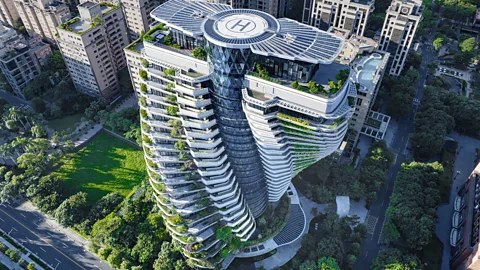 BES Engineering
BES EngineeringThe ability of those extraordinary constructions to change how folks reside and really feel is central to their design. Considered one of Vincent Callebaut Architectures’ newest designs is The Rainbow Tree (Cebu, Philippines), impressed by the psychedelic colors of the native Rainbow Eucalyptus Tree‘s bark. However the “tree” requires the collaboration of the residents of every of its 300 residences to keep up its hanging flora. This, together with its shared greenhouses and concrete beehives, helps “foster social bonds”, says Callebaut, creating a way of neighborhood and connection.
This notion that biophilic design (design that attracts on people’ innate reference to nature) can positively have an effect on our wellbeing is supported by current analysis. A study undertaken by Wageningen College within the Netherlands reported that the presence of crops in a piece setting not solely improved the attractiveness of the workspace, but in addition elevated worker satisfaction. Employees additionally observed the improved air high quality and reported fewer health-related complaints.
In Wales, a 10-year study trying on the presence of hysteria and despair in 2.3 million medical information, discovered that the greenest dwelling environment have been related to 40% much less anxiousness and despair than these dwelling within the least inexperienced areas. Folks in poorer areas benefitted essentially the most, with entry to inexperienced areas and water lowering the chance of hysteria and despair by 10% (6% in wealthier areas).
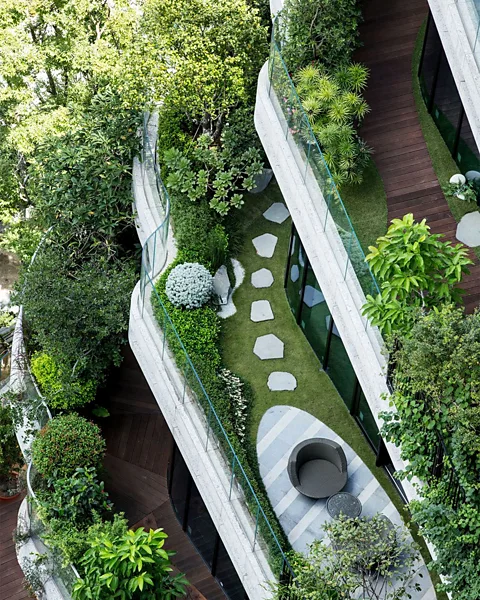 BES Engineering
BES EngineeringIt’s maybe unsurprising, then, that biophilic ideas are being commissioned for brand new hospitals. Callebaut’s Hospiwood 21, in La Louvière, Belgium, says the architect, “incorporates therapeutic vertical forests utilizing greenery to scale back affected person stress and improve restoration”, and is furnished with a soothing biophilic interior stuffed with cascading crops. In the meantime, in Italy, Stefano Boeri’s New Policlinico Hospital Milan will function a rooftop backyard of greater than 7,000 sq. metres. Biophilia is a part of a rethinking of care amenities, says Boeri, that “opens up a brand new perspective on rehabilitation, going past the normal idea of a facility for the mere long-term care of sufferers and changing into a real house of interplay and wellbeing in shut contact with nature”.
Actually, the inexperienced tendrils of biophilic design are creeping into an enormous vary of buildings. Jewel Changi Airport, Singapore’s 10-storey leisure and retail advanced, has been open to each air passengers and guests since 2019, and boasts lush indoor forests comprising 1,400 timber, in addition to the world’s tallest indoor waterfall (40m). In Amsterdam, the sustainable bamboo inside of the Hotel Jakarta (based 2018) encompasses a tropical backyard in its central atrium that, quenched by rainwater from the roof, is quick advancing in the direction of its 30-metre excessive ceiling. An hour away in Rotterdam, a rooftop forest, nearly 40m above floor degree, crowns The Depot, a publicly accessible storage facility for the huge artwork assortment of the Museum Boijmans van Beuningen, and formed like a large mirrored cauldron.
In addition to lifting our spirits, high-rise forests can play an necessary function in tackling local weather change. Vincent Callebaut’s Tao Zhu Yin Yuan in Taipei, Taiwan, a 21-floor tower that’s formed like DNA’s double helix, was accomplished in 2024. Its 23,000 crops soak up an estimated 130 tons of CO2 annually, and their cooling impact on the façade reduces the necessity for air con by 30%. The constructing options rotating balconies to maximise solar publicity, whereas the air flow chimneys at its core displays Callebaut’s curiosity in biomimicry (the emulation of nature’s programs to offer options to human issues) and performance very like a lung, drawing in air at its base, purifying it, after which expelling it on the prime.
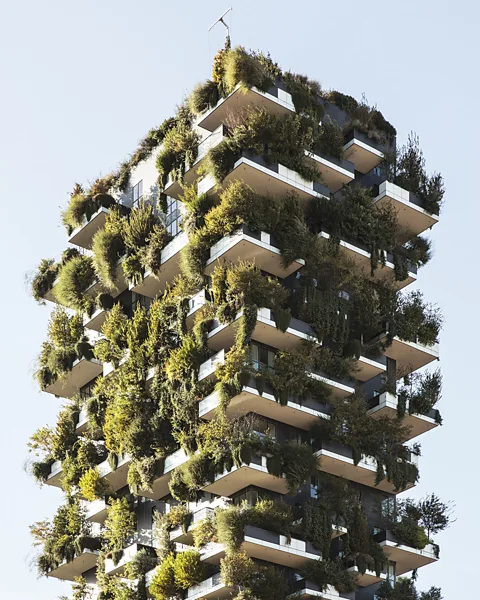 Boeri Studio/ Giovanni Nardi
Boeri Studio/ Giovanni NardiFar taller than they’re extensive, high-rise forests additionally minimise soil sealing, releasing up land for nature and lowering flood threat. “My tasks embody a imaginative and prescient the place cities are now not local weather issues however dwelling options,” says Callebaut. Removed from nature being “an impediment or decorative afterthought”, it is the tenet of the design. Buildings now act, he says, as “inhabited timber… that soak up CO2, produce vitality, and shelter biodiversity”. Responding to 2 main modern crises, international warming and declining psychological well being, biophilic buildings are already being envisaged as a part of solely forested cities. In Liuzhou in China’s Guangxi province, one of many world’s worst areas for smog, Stefano Boeri’s futuristic Forest City, housing round 30,000 inhabitants and producing all of its personal vitality, has been permitted and is awaiting development; whereas the agency’s Cancun Smart Forest City in Mexico, which plans to ban combustion-powered automobiles, can be awaiting starter’s orders.
Again in Milan, the constructing that started all of it, with its rooftop photo voltaic panels, is indisputably tree-like, harvesting its vitality from the solar and drawing up groundwater. “Nature is just not one thing that exists in an immemorial previous,” writes writer and thinker Emanuele Coccia within the ebook. “It’s and can all the time be our technological future.” As for Boeri, the dual vertical forests he dropped at life in Milan usually are not simply buildings, he writes, however “a political manifesto” with “a easy and well-liked message: dwelling nature has to return to inhabit the areas conceived for people. No extra, no much less”.

